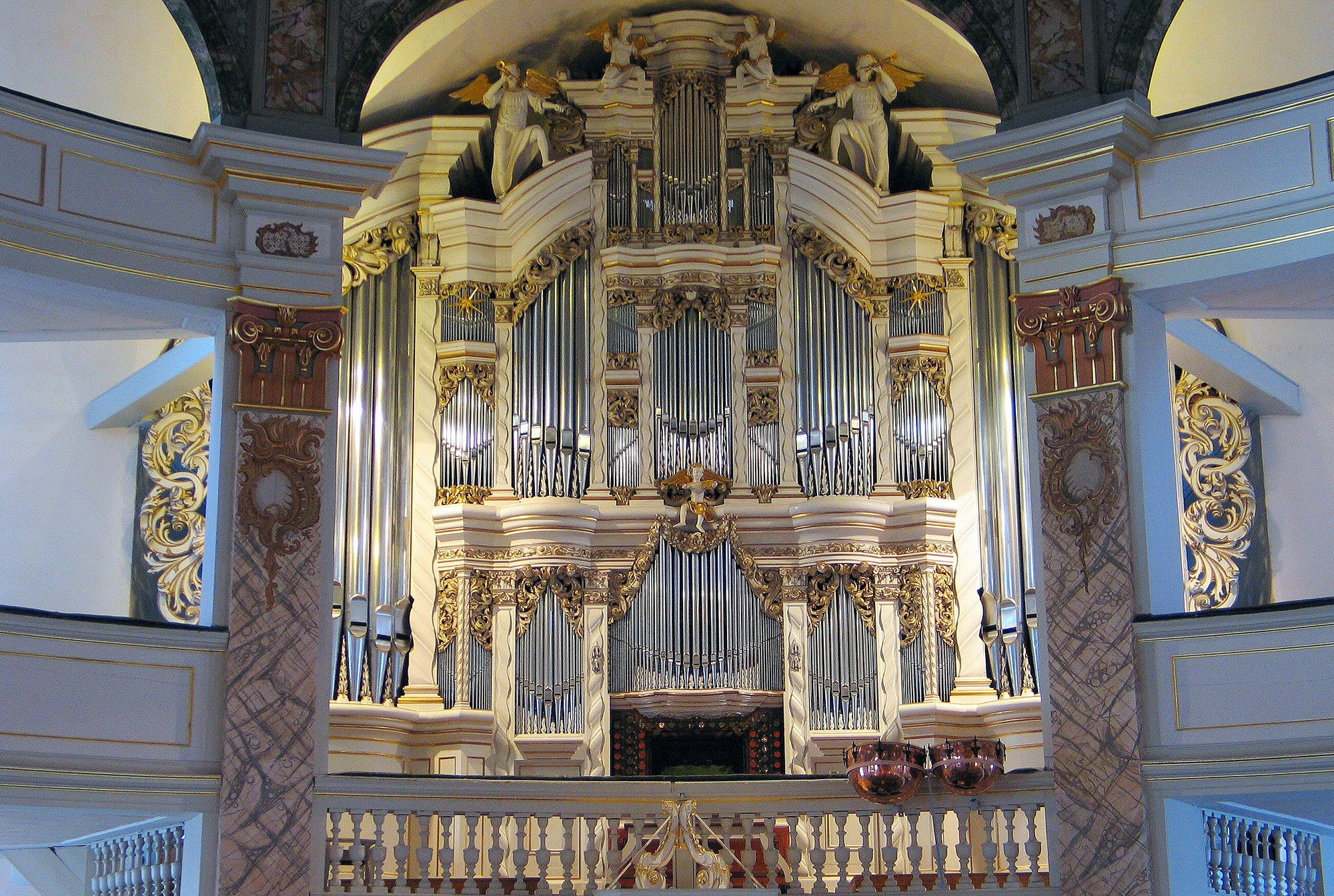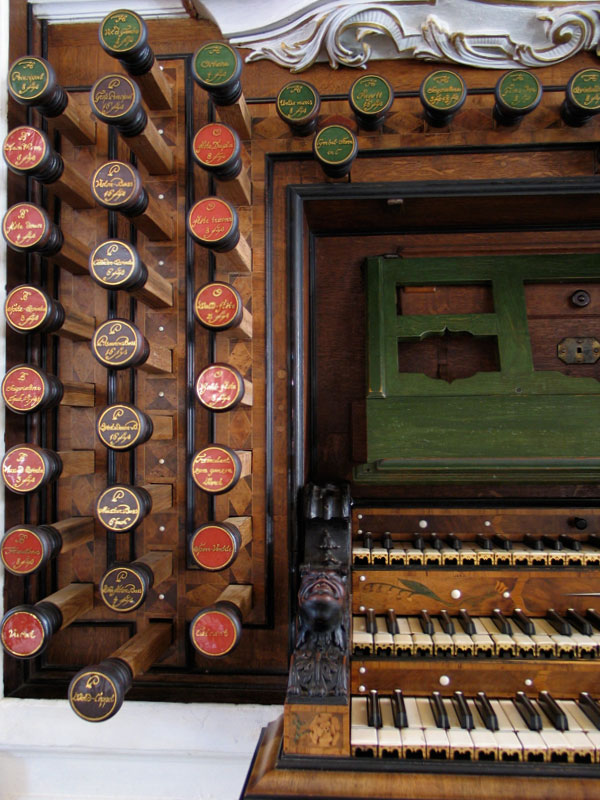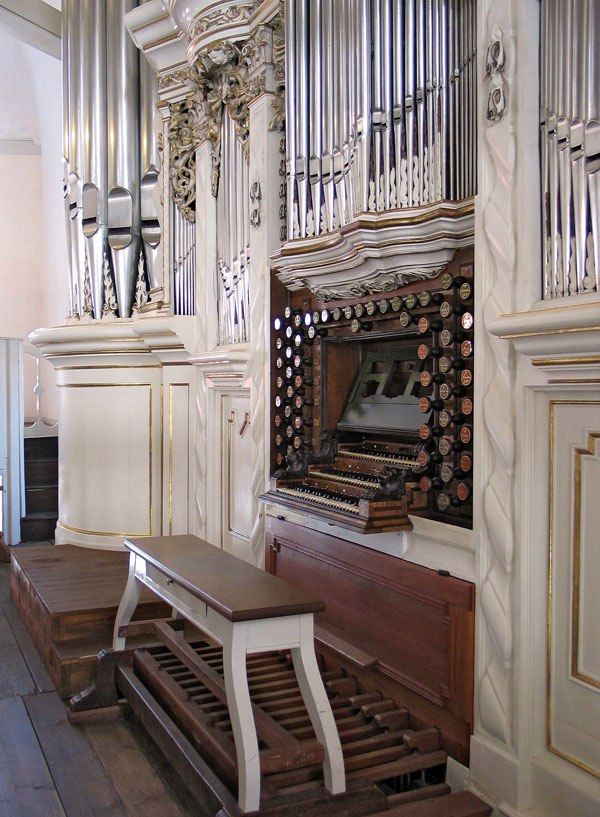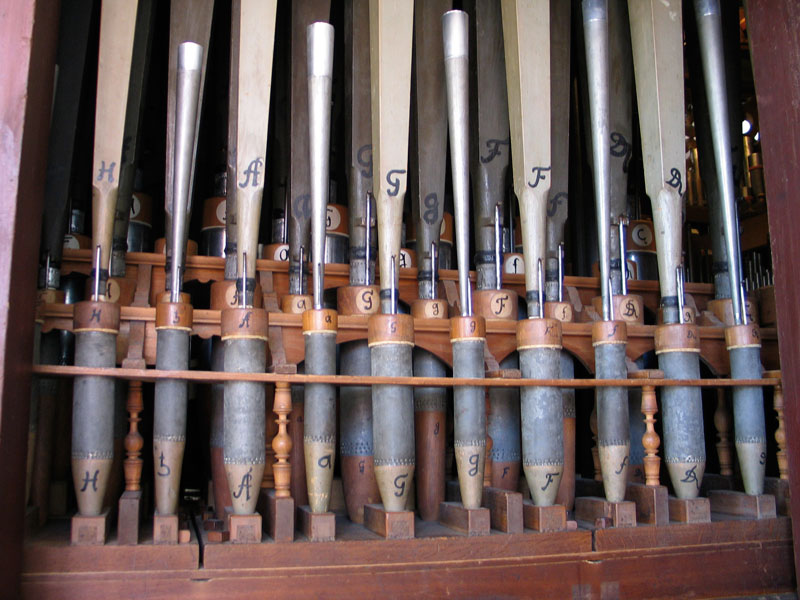Waltershausen, Stadtkirche Zur Gotteshilfe
| Builder | T. H. G. Trost |
|---|---|
| Year | 1730 |
| Period/Style | Baroque |
| Stops | 53 |
| Keyboards | 3+P |
| Keyaction | tracker/mechanical |
| Tuning | 1/5 Comma Meantone at 466.8 Hz |
| Sampleset |
Available
 , sampled by
OrganArt Media
, sampled by
OrganArt Media
|
The Trost organ in Waltershausen, with its 47 stops and 6 pedal transmissions, is the largest Baroque organ in Thuringia. Largely preserved in its original state from 1730 (with about 70% of the pipes originating from Trost himself), it is an exceptionally valuable reference instrument for performing the organ works of Bach and his contemporaries. This organ is considered to closely match Bach's sonic ideals.
The organ was built between 1724 and 1730 by Tobias Heinrich Gottfried Trost, but due to several changes in the organ's design during construction and significant conflicts between Trost and the patrons, it was possibly completed around 1755 by organ builder Johann Heinrich Ruppert. The instrument survived the centuries without major alterations and was restored to its 1730 condition by Orgelbau Waltershausen from 1994 to 1998.
As a typical instrument of the Thuringian organ-building tradition, it features characteristic stops like the Violonbass in the pedal, Terzmixturen, Sesquialtera, and Viola di Gamba. These stops, along with a wealth of well-blending registers, allow for an endless array of tonal combinations, paving the way for the German Romantic organ of the following century. Trost's extraordinary and innovative concepts with unusual and extreme pipe scales for stops like the Geigenprincipal, Flauto traverse, and Vagarr, as well as "lovely" stops like Flauto dolce, Flöte dupla, and Nachthorn, which Bach greatly valued, were precursors of the so-called "galant style."
The organ case, designed by Johann Eberhard Strassburger, the architect of the Anna Amalia Library in Weimar, is of exceptional beauty and elegance, with the original manuals still preserved. While it is not definitively known, it is believed that Bach himself played this instrument. It is recorded that Bach highly appreciated the sound and craftsmanship of Trost's organs during his 1739 visit to Altenburg. The church's architecture, with its circular design and surrounding galleries on multiple levels, designed by Wolf Christoph Zorn von Plobsheim, was a precursor to the Dresden Frauenkirche. The interior's unique combination of altar, pulpit, and organ reflects the Lutheran ideal of unity between music and preaching, a concept also seen in the Frauenkirche Dresden.
The organ was built between 1724 and 1730 by Tobias Heinrich Gottfried Trost, but due to several changes in the organ's design during construction and significant conflicts between Trost and the patrons, it was possibly completed around 1755 by organ builder Johann Heinrich Ruppert. The instrument survived the centuries without major alterations and was restored to its 1730 condition by Orgelbau Waltershausen from 1994 to 1998.
As a typical instrument of the Thuringian organ-building tradition, it features characteristic stops like the Violonbass in the pedal, Terzmixturen, Sesquialtera, and Viola di Gamba. These stops, along with a wealth of well-blending registers, allow for an endless array of tonal combinations, paving the way for the German Romantic organ of the following century. Trost's extraordinary and innovative concepts with unusual and extreme pipe scales for stops like the Geigenprincipal, Flauto traverse, and Vagarr, as well as "lovely" stops like Flauto dolce, Flöte dupla, and Nachthorn, which Bach greatly valued, were precursors of the so-called "galant style."
The organ case, designed by Johann Eberhard Strassburger, the architect of the Anna Amalia Library in Weimar, is of exceptional beauty and elegance, with the original manuals still preserved. While it is not definitively known, it is believed that Bach himself played this instrument. It is recorded that Bach highly appreciated the sound and craftsmanship of Trost's organs during his 1739 visit to Altenburg. The church's architecture, with its circular design and surrounding galleries on multiple levels, designed by Wolf Christoph Zorn von Plobsheim, was a precursor to the Dresden Frauenkirche. The interior's unique combination of altar, pulpit, and organ reflects the Lutheran ideal of unity between music and preaching, a concept also seen in the Frauenkirche Dresden.
| Hauptwerk | Brustwerk | Oberwerk | Pedal |
|---|---|---|---|
| Portun-Untersatz 16 | Gedackt 8 | Flöte Dupla 8 | Groß-Principal 16 |
| Groß Qvintadena 16 | Nachthorn 8 | Vagarr 8 | Sub-Bass 16 |
| Principal 8 | Principal 4 | Flöte travers 8 | Violon-Bass 16 |
| Gemshorn 8 | Flöte douce 4 | liebl. Principal 4 | Octaven-Bass 8 |
| Viol d’ Gambe 8 | Nachthorn 4 | Spitzflöte 4 | Celinder-Qvinta 6 |
| Portun 8 | Gemshorn 4 | Gedackt-Qvinta 3 | Posaunen-Bass 32 |
| Qvintadena 8 | Spitz-Qvinta 3 | Wald-Flöte 2 | Posaunen-Bass 16 |
| Unda maris 8 | Nassad-Qvinta 3 | Hohl-Flöte 8 | Trompetten-Bass 8 |
| Octava 4 | Octava 2 | Vox humana 8 | Qvintadenen-Bass 16 (Trans) |
| Salcional 4 | Sesqvialtera 2 fach | Geigenprincipal 4 | Viol d’Gamben-Bass 8 (Trans) |
| Röhr-Flöta 4 | Mixtura 4 fach | Portun-Bass 8 (Trans) | |
| Celinder-Qvinta 3 | Hautbous 8 | Super-Octava 4 (Trans) | |
| Super-Octava 2 | Röhr-Flöten-Bass 4 (Trans) | ||
| Sesqvialtera 2 fach | Mixtur-Baß 6fach (Trans) | ||
| Mixtura 8 fach | |||
| Fagott 16 | |||
| Trompetta 8 |
BWV5472
0:00
0:00
BWV582-Passacaglia
0:00
0:00
https://www.organartmedia.com/de/heinrich-gottfried-trost#geschichtliches
 Pipe Organ Map
Pipe Organ Map


